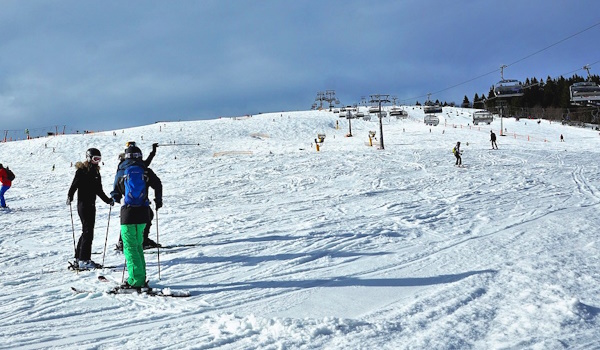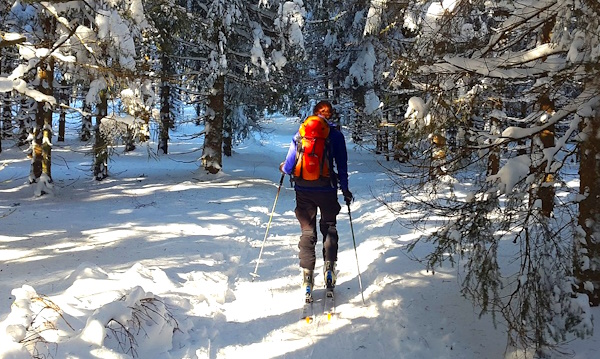Black Forest ski areas
Skiing in the Black Forest is popular with locals and tourists alike. Some of the most famous ski areas in the Black Forest are listed below.
The Feldberg is the highest peak in the Black Forest and Germany’s most famous ski resort. Located at an altitude of 1,493 meters, it offers skiers and snowboarders a wide range of slopes and activities in winter. Information about the Feldberg ski area is available

Slopes: The Feldberg ski area offers more than 25 km of slopes of varying levels of difficulty, from easy and wide family slopes to challenging slopes.
Lifts: Numerous chair lifts, drag lifts and gondolas transport skiers and snowboarders to the start of the slopes.
Best city tour Freiburg: “Gässle, Bächle und mehr” is a great city tour with a guide. You can see the old town with its famous alleyways and streams, the famous cathedral and much more. Daily 1-2 times. Bookable online at Getyourguide for just 12 euros in 2023: More info and booking
Snow reliability: Thanks to its altitude, the Feldberg has relatively good snow reliability in the Black Forest. In order to extend the ski season, many slopes are also covered with snow using snow cannons.
Ski schools: There are several ski schools in Feldberg that offer courses for beginners and advanced skiers. Here you can learn to ski or snowboard and improve your skills.
Cross-country skiing: In addition to alpine skiing, there are also numerous cross-country ski trails in the Feldberg area.
Particularly known for ski jumping and ski jumps.
There are also several cross-country ski trails.
A small ski area near the Feldberg.
It offers slopes for both beginners and advanced skiers.
Berchen:
Located in one of the most beautiful landscapes in the Black Forest, with some excellent slopes.
Münsterthal:.
Ideal for beginners and families.
Gentle slopes and beautiful hiking trails.
Schonach:.
Another popular area for cross-country skiers with kilometers of trails.
Baiersbronn:.
Famous for its cross-country ski trails.
There are also several smaller slopes.
In addition to these ski areas, the Black Forest offers many other opportunities for skiing, snowboarding and cross-country skiing. There are also winter hiking trails and toboggan runs in many areas. It is advisable to find out about current snow conditions and opening times before visiting.
Winter sports Black Forest
The Black Forest in Germany is a popular destination for winter sports enthusiasts. In addition to skiing and snowboarding, the Black Forest offers a variety of other winter sports.
Alpine skiing: As already mentioned, the Black Forest offers a variety of ski areas, of which Feldberg is the largest. Other ski areas include Tortnauberg, Berchen and Baiersbronn.
Cross-country skiing: The Black Forest has an extensive network of cross-country ski trails. Popular cross-country skiing areas include the raised moors of Hinterzarten, the trails around Lake Titisee, Schonach and Baiersbronn.

Snowshoe hiking: If you want to enjoy the snowy landscape away from the pistes, you will find numerous snowshoe hiking trails in the Black Forest.
Tobogganing: There are toboggan runs in many parts of the Black Forest. Feldberg and Totnau are just two of the many places where you can toboggan.
Ice skating: There are several ice skating rinks in the Black Forest, both indoor and outdoor. Examples are the ice rink in Freiburg and the natural ice rink in Titisee.
Winter hiking: Many hiking trails in the Black Forest are also accessible in winter. With sturdy shoes and a hiking stick, you can explore the winter landscape on foot.
Ski jumping: Hinterzarten is particularly known for its ski jumping and ski jumping events.
Biathlon: In some areas of the Black Forest, such as B. in Schonach, there are biathlon centers where competitions are held and you can try out a combination of cross-country skiing and shooting.
Snow guaranteed wild boar
The reliability of snow in the Black Forest depends heavily on the altitude, the respective weather conditions and the time of year. General rules:.
Altitude: Higher areas, such as the Feldberg (highest point in the Black Forest at 1,493 m), are more likely to have snow than lower areas. The Feldberg area is usually snow-sure from December to March and is the snowiest area in the Black Forest.
Winter sports season: The main winter season in the Black Forest is from December to February. Depending on the year, the ski season can start as early as November and last until April, especially in the higher areas.
Artificial snow: Some of the larger ski areas in the Black Forest, especially in Feldberg, have snow plows that can produce artificial snow if necessary to improve piste conditions and extend the ski season.
Cross-country skiing: For cross-country skiers, snow reliability can be more inconsistent, especially at lower altitudes. However, there are many trails at higher altitudes where snow is guaranteed.
Climate change Black Forest
Climate change has particular effects on winters in the Black Forest. These changes are important for both the local ecosystem and the economy, especially in relation to winter tourism. The specific effects of climate change on the Black Forest in winter are
Shorter winter season: The winter season tends to start later and end earlier. This reduces the number of days with guaranteed snow and affects winter tourism.
Lower snow amounts: Average snow amounts are decreasing, especially at lower elevations, and there are fewer snow days. This can lead to a shortened ski season in many areas of the Black Forest.
Increasing demand for artificial snow: In order to extend the ski season and improve piste conditions, many ski areas are increasingly relying on snowmaking systems. This increases water and energy requirements and can have ecological impacts.
Threat to winter tourism: Winter tourism, especially skiing and cross-country skiing, is an important economic factor for the Black Forest. A lower level of snow reliability is a major challenge for tourism professionals, hoteliers and other industries.
Ecological effects: The changes in winter also affect flora and fauna. Some animals that rely on snow may have their habitat restricted.
Increased risk of natural events: Higher temperatures can increase the risk of avalanches in steep areas, although this is not as problematic in the Black Forest as it is in the Alps. Additionally, heavy rainfall and melting snow may cause flooding in certain areas.
Adaptation strategies: In view of the challenges of climate change, many communities and companies in the Black Forest have developed adaptation strategies. This includes investments in summer tourism, the development of climate-resilient ski resorts and efforts to raise public awareness and education about climate change.